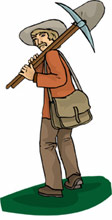
Worksheets and No Prep Teaching Resources
California Gold Rush
 Worksheets and No Prep Teaching Resources |
California Gold Rush |
| edHelper's suggested reading level: | grades 4 to 6 | |
| Flesch-Kincaid grade level: | 6.86 |
| Print California Gold Rush (font options, pick words for additional puzzles, and more) |
|
| Quickly print reading comprehension |
|
| Print a proofreading activity |
| Leave your feedback on California Gold Rush (use this link if you found an error in the story) |
|
California Gold Rush
By Shirley Kruenegel |

|
 1 On January 24, 1848, James Marshall spotted glittering flakes of gold in the American River. At the time he was working on helping to build a saw mill for John Sutter. He quickly took the gold to show Mr. Sutter and to get it tested. Sutter asked Marshall to keep the discovery of gold a secret until the construction of his mill was completed. However, that was one secret that was impossible to keep because gold is a rare, soft, valuable metal.
1 On January 24, 1848, James Marshall spotted glittering flakes of gold in the American River. At the time he was working on helping to build a saw mill for John Sutter. He quickly took the gold to show Mr. Sutter and to get it tested. Sutter asked Marshall to keep the discovery of gold a secret until the construction of his mill was completed. However, that was one secret that was impossible to keep because gold is a rare, soft, valuable metal.